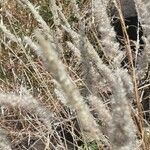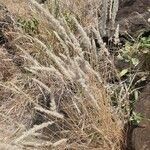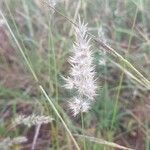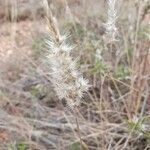Tufted perennial; culms wiry below, 3–40 cm. high, usually shortly hairy all over, the base often clad in the fibrous remains of the previous year’s growth.. Leaf-blades up to 10 cm. long, involute, rarely flat and then up to 2 mm. broad.. Inflorescence a spike-like panicle, ovate to irregularly cylindrical, 2–8 cm. long.. Glumes both 3–9-nerved, the lower 2.5–5 mm. long, the upper 2.8–5.5 mm. long; lowest lemma 1.5–2 mm. long, its awns 2.5–5 mm. long and densely ciliate for much of their length; second lemma smaller, usually ♂; third lemma 0.5–2 mm. long, including the awns which are reduced to a small tuft; anthers 0.3–0.5 mm. long.. Fig. 55/9, p. 168.
Densely tufted annual or possibly perennial, 30-300 mm high, usually densely hairy with gland-tipped hairs; leaf sheaths persistent, fibrous; culms often branched, geniculate or decumbent. Leaf blade 25-250 x 7 mm or filiform; ligule a fringe of hairs. Inflorescence a dense, spike-like panicle. Spikelet 3.5-5.5 mm long (including awns); glumes light to dark grey. Florets 3; lemma not keeled, 9-lobed, lobes awned; awns plumose for up to 2/3 their length; anther 0.2-0.7(-1.4) mm long. Flowering time Jan.-Dec., usually in summer but rarely in winter in the north.
Densely tufted, compacted annual or perennial 30-300 mm high; often stoloniferous; base may be bulbous; densely hairy with gland-tipped hairs; leaf sheaths persistent, fibrous; culms simple or branched, then often at swollen nodes, geniculate or decumbent. Leaf blade 25-250 x 7 mm, filiform. Inflorescence spike-like, dense, light coloured to dark grey. Spikelet 3.5-5.5 mm long (including awns), 3-flowered, upper floret reduced to tuft of awns; glumes pallid to dark grey; lemma awns plumose for 2/3 their length; anther 0.2-0.7(-1.4) mm long.
Perennial or annual; up to 0.3 m high; densely tufted; glandular-hairy; base densely leafy; often stoloniferous. Culms often decumbent; nodes with a ring of hairs; basal leaf sheaths often persistent; breaking into fibres. Leaf blades 25-250 mm long; filiform or up to 7 mm wide. Flowers: panicle spike-like; dense; unbranched; spikelets 3.0-5.5 mm long; lemma awns hair-fringed; anthers 0.2-0.7(-1.2) mm long.
Glandular hairy perennial or annual, up to 300 mm tall, culms branched, geniculate. Leaves linear to filiform, tapering to a very fine point; ligule a fringe of hairs. Inflorescence a dense spike-like panicle, light to dark grey. Spikelets 3-5.5 mm long, usually 3-flowered; glumes subequal; lemma long hairy, 9-awned, awns plumose, extending beyond glumes. Mostly Nov.-Mar.
Possibly perennial or annual, densely tufted, up to 300 mm tall, densely glandular-hairy. Leaf blades 25-250 mm long, filiform or up to 7 mm wide. Nodes with a ring of hairs; culms often decumbent. Spikelets 3.0-5.5 mm long. Panicle spike-like, dense, unbranched; lemma awns hair-fringed; anthers 0.2-0.7(-1.2) mm long.
A herb. It is an annual grass that forms tufts. It has stolons or runners and can keep growing from year to year. It grows 40 cm high. It has a ring of hairs around the nodes. The stalks are usually bent. The leaves are usually short and rolled. They are 3-25 cm long by 1-3 mm wide. The flower groups are 1-5 cm long.
Leaves mostly confined to the base, forming dense tufts; sheaths tight at first later somewhat loose, finely to coarsely striate, the oldest long-persistent and splitting into fibres which form dense cushions at the base of the culm.
Glumes subequal, oblong, scantily pilose, with the apex obtuse to slightly emarginate, light to dark grey; the inferior 2.3-5 mm. long, 3-7-nerved; the superior 2.8-5.5 mm. long, 3-5-nerved.
Culms 5-15 (rarely to 40) cm. tall, 2-5-noded, geniculately ascending, sometimes decumbent, often with a bulbous thickening at the base, simple or branched, rather slender, asperulous.
Fertile lemma (the inferior) 1.5-2 mm. long (excluding the awns), dorsally shortly villous; awns 2-4 mm. long, shortly plumose to or beyond the middle.
Glandular-hairy perennial or annual to 30 cm. Leaves linear to filiform. Spikelets in a dense spike-like panicle. Lemma awns plumose.
Panicle 1.5-5(7.5) cm. long, spike-like, narrowly cylindrical or rarely ovate-oblong in outline, rather dense, light to dark grey.
Leaf-laminae 2.5-7.5(12) x 0.3-0.5 cm., filiform, almost always convolute, tapering to a very fine point, flexible, asperulous.
A compact caespitose often stoloniferous perennial, usually densely glandular-pubescent all over.
Spikelets 3-5.5 mm. long, 3-flowered (see note below), crowded.
Anthers 0.3-0.5 (rarely 0.7) mm. long.
Tufted perennial up to 23 cm. high.
Caryopsis c. 1 mm. long.




